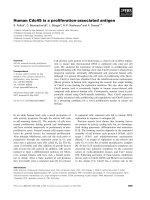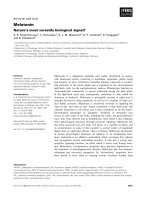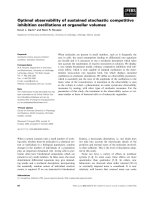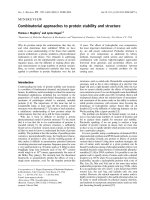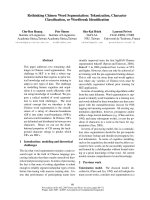Báo cáo khoa học: "Optimal Multi-Paragraph Text Segmentation by Dynamic Programming" pdf
Bạn đang xem bản rút gọn của tài liệu. Xem và tải ngay bản đầy đủ của tài liệu tại đây (264.42 KB, 3 trang )
Optimal Multi-Paragraph Text Segmentation by Dynamic Programming
Oskari Heinonen
University of Helsinki, Department of Computer Science
P.O. Box 26 (Teollisuuskatu 23), FIN-00014 University of Helsinki, Finland
Oskari.Heinonen @ cs.Helsinki.FI
Abstract
There exist several methods of calculating a similar-
ity curve, or a sequence of similarity values, repre-
senting the lexical cohesion of successive text con-
stituents, e.g., paragraphs. Methods for deciding
the locations of fragment boundaries are, however,
scarce. We propose a fragmentation method based
on dynamic programming. The method is theoret-
ically sound and guaranteed to provide an optimal
splitting on the basis of a similarity curve, a pre-
ferred fragment length, and a cost function defined.
The method is especially useful when control on
fragment size is of importance.
1 Introduction
Electronic full-text documents and digital libraries
make the utilization of texts much more effective
than before; yet, they pose new problems and re-
quirements. For example, document retrieval based
on string searches typically returns either the whole
document or just the occurrences of the searched
words. What the user often is after, however, is mi-
crodocument: a part of the document that contains
the occurrences and is reasonably self-contained.
Microdocuments can be created by utilizing lex-
ical cohesion (term repetition and semantic rela-
tions) present in the text. There exist several meth-
ods of calculating a similarity curve, or a sequence
of similarity values, representing the lexical cohe-
sion of successive constituents (such as paragraphs)
of text (see, e.g., (Hearst, 1994; Hearst, 1997; Koz-
ima, 1993; Morris and Hirst, 1991; Yaari, 1997;
Youmans, 1991)). Methods for deciding the loca-
tions of fragment boundaries are, however, not that
common, and those that exist are often rather heuris-
tic in nature.
To evaluate our fragmentation method, to be ex-
plained in Section 2, we calculate the paragraph
similarities as follows. We employ stemming, re-
move stopwords, and count the frequencies of the
remaining words, i.e., terms. Then we take a pre-
defined number, e.g., 50, of the most frequent terms
to represent the paragraph, and count the similar-
ity using the cosine coefficient (see, e.g., (Salton,
1989)). Furthermore, we have applied a sliding win-
dow method: instead of just one paragraph, sev-
eral paragraphs on both sides of each paragraph
boundary are considered. The paragraph vectors are
weighted based on their distance from the boundary
in question with immediate paragraphs having the
highest weight. The benefit of using a larger win-
dow is that we can smooth the effect of short para-
graphs and such, perhaps example-type, paragraphs
that interrupt a chain of coherent paragraphs.
2 Fragmentation by Dynamic
Programming
Fragmentation is a problem of choosing the para-
graph boundaries that make the best fragment
boundaries. The local minima of the similarity
curve are the points of low lexical cohesion and thus
the natural candidates. To get reasonably-sized mi-
crodocuments, the similarity information alone is
not enough; also the lengths of the created frag-
ments have to be considered. In this section, we de-
scribe an approach that performs the fragmentation
by using both the similarities and the length infor-
mation in a robust manner. The method is based on
a programming paradigm called dynamic program-
ming (see, e.g., (Cormen et al., 1990)). Dynamic
programming as a method guarantees the optimal-
ity of the result with respect to the input and the
parameters.
The idea of the fragmentation algorithm is as fol-
lows (see also Fig. 1). We start from the first bound-
ary and calculate a cost for it as if the first paragraph
was a single fragment. Then we take the second
boundary and attach to it the minimum of the two
available possibilities: the cost of the first two para-
graphs as if they were a single fragment and the cost
1484
fragmentation(n,
p, h, len[1 n], sim[1 n -
1])
/* n no. of pars, p preferred frag length, h scaling */
I* len[1 n]
par lengths,
sim[1 n -
1] similarities */
{
sire[O]
:= 0.0;
cost[O]
:= 0.0; B := 0;
for
par
:= 1 to n {
lensum
:= 0;/* cumulative fragment length */
emin :=
MAXREAL;
for i :=
par
to I {
lensum
:=
lensurn + len[i];
c :=
Cle,(lensum, p,
h);
if e ~> emin { /*
optimization */
exit the innermost for loop;
}
e :=
c + cost[i -
1] +
sim[i -
1];
if C < Cmin {
Cmin := C; IOC-Cmin := i 1;
}
}
cost~ar]
:=
Cmin;
linkp,ev[par]
:=
lot-train;
}
j := n;
while
linkprev[j] > 0 {
B :=
B t_J linkprev[j]; j
:=
linkprev[j];
)
return(B);/* set of chosen fragment boundaries */
Figure 1: The dynamic programming algorithm for
fragment boundary detection.
of the second paragraph as a separate fragment. In
the following steps, the evaluation moves on by one
paragraph at each time, and all the possible loca-
tions of the previous breakpoint are considered. We
continue this procedure till the end of the text, and
finally we can generate a list of breakpoints that in-
dicate the fragmentation.
The cost at each boundary is a combination of
three components: the cost of fragment length Clen,
and the cost
cost[.]
and similarity
sim[.]
of some
previous boundary. The cost function Clen gives the
lowest cost for the preferred fragment length given
by the user, say, e.g., 500 words. A fragment which
is either shorter or longer gets a higher cost, i.e., is
punished for its length. We have experimented with
two families of cost functions, a family of second
degree functions (parabolas),
~z + 1),
and V-shape linear functions,
Clen(X,p,h)
= Ih(~ - 1)1,
1485
Mats.
Chaplet II. Section I.
i
0.S
0.4 .,~
0.3 t ¢
0.2
0.1
0 IT
1000
i
Ill
2OOO
I '
i ,
i
3000 4000 5000
wocdcounl
(a)
"W6ClinHO.25L"
"W6ClinH0.SL"
"W6ClinH0.75L"
"W6ClinH 1.0L"
"W6ClinH 1.25L"
"W6ClinH 1 .SL"
• W6L •
II1~11 -7
6000 7000
Mars. Chapter IL Section
I.
i
0.6
"~ 0.5
0.4
0.3
0.2
0.1
0
t i! ,
IH I
1000 2000 3000 4000
"W6CparH0.25L" •
"W6C~rH0.SL" •
"W6CparH0.75L" •
"W6CparH1.0L" •
T "W6CI~d-11.2$L" *
'WSCparHI.SL" •
• "W61."
If 111
-ii 7
5000 6000 7000
wotdt~mnt
(b)
Figure 2: Similarity curve and detected fragment
boundaries with different cost functions. (a) Lin-
ear. (b) Parabola. p is 600 words in both (a) & (b).
"H0.25", etc., indicates the value of h. Vertical bars
indicate fragment boundaries while short bars below
horizontal axis indicate paragraph boundaries.
where x is the actual fragment length, p is the pre-
ferred fragment length given by the user, and h is a
scaling parameter that allows us to adjust the weight
given to fragment length. The smaller the value of
h, the less weight is given to the preferred fragment
length in comparison with the similarity measure.
3 Experiments
As test data we used
Mars
by Percival Lowell, 1895.
As an illustrative example, we present the analysis
of Section I.
Evidence of it
of Chapter II.
Atmo-
sphere. The
length of the section is approximately
6600 words and it contains 55 paragraphs. The frag-
ments found with different parameter settings can
be seen in Figure 2. One of the most interesting is
the one with parabola cost function and h = .5. In
this case the fragment length adjusts nicely accord-
ing to the similarity curve. Looking at the text, most
fragments have an easily identifiable topic, like at-
mospberic chemistry in fragment 7. Fragments 2
and 3 seem to have roughly the same topic: measur-
ing the diameter of the planet Mars. The fact that
they do not form a single fragment can be explained
cost function
linear
parabola
h
.25
.50
.75
1.00
1.25
1.50
.25
.50
.75
1.00
1.25
1.50
lavg /min /max davg
1096.1 501 3101 476.5
706.4 501 1328 110.5
635.7 515 835 60.1
635.7 515 835 59.5
635.7 515 835 59.5
635.7 515 835 57.6
908.2 501 1236 269.4
691.0 319 1020 126.0
676.3 371 922 105.8
662.2 371 866 94.2
648.7 466 835 82.4
635.7 473 835 69.9
Table 1: Variation of fragment length. Columns:
lavg, lmin, Imax average, minimum, and maximum
fragment length; and davg average deviation.
by the preferred fragment length requirement.
Table 1 summarizes the effect of the scaling fac-
tor h in relation to the fragment length variation
with the two cost functions over those 8 sections
of
Mars
that have a length of at least 20 para-
graphs. The average deviation
davg
with respect
to the preferred fragment length p is defined as
davg
= (~-'~n= 1 [P
lil)/m
where
li
is the length of
fragment i, and m is the number of fragments. The
parametric cost function chosen affects the result a
lot. As expected, the second degree cost function
allows more variation than the linear one but roles
change with a small h. Although the experiment is
insufficient, we can see that in this example a factor
h > 1.0 is unsuitable with the linear cost function
(and h = 1.5 with the parabola) since in these cases
so much weight is given to the fragment length that
fragment boundaries can appear very close to quite
strong local maxima of the similarity curve.
4 Conclusions
In this article, we presented a method for detect-
ing fragment boundaries in text. The fragmentation
method is based on dynamic programming and is
guaranteed to give an optimal solution with respect
to a similarity curve, a preferred fragment length,
and a parametric fragment-length cost function de-
fined. The method is independent of the similarity
calculation. This means that any method, not nec-
essarily based on lexical cohesion, producing a suit-
able sequence of similarities can be used prior to
our fragmentation method. For example, the
lexical
cohesion profile
(Kozima, 1993) should be perfectly
usable with our fragmentation method.
1486
The method is especially useful when control
over fragment size is required. This is the case
in passage retrieval since windows of 1000 bytes
(Wilkinson and Zobel, 1995) or some hundred
words (Callan, 1994) have been proposed as best
passage sizes. Furthermore, we believe that frag-
ments of reasonably similar size are beneficial in
our intended purpose of document assembly.
Acknowledgements
This work has been supported by the Finnish
Technology Development Centre (TEKES) together
with industrial partners, and by a grant from the
350th Anniversary Foundation of the University
of Helsinki. The author thanks Helena Ahonen,
Barbara Heikkinen, Mika Klemettinen, and Juha
K~kk~iinen for their contributions to the work de-
scribed.
References
J. P. Callan. 1994. Passage-level evidence in doc-
ument retrieval. In
Proc. SIGIR'94,
Dublin, Ire-
land.
T. H. Cormen, C. E. Leiserson, and R. L. Rivest.
1990.
Introduction to Algorithms.
MIT Press,
Cambridge, MA, USA.
M. A. Hearst. 1994. Multi-paragraph segmentation
of expository text. In
Proc. ACL-gg,
Las Cruces,
NM, USA.
M. A. Hearst. 1997. TextTiling: Segmenting text
into multi-paragraph subtopic passages.
Compu-
tational Linguistics,
23(1):33-64, March.
H. Kozima. 1993. Text segmentation based on sim-
ilarity between words. In
Proc. ACL-93,
Colum-
bus, OH, USA.
J. Morris and G. Hirst. 1991. Lexical cohesion
computed by thesaural relation as an indicator of
the structure of text.
Computational Linguistics,
17(1):21-48.
G. Salton. 1989.
Automatic Text Processing: The
Transformation, Analysis, and Retrieval of lnfor-
mation by Computer.
Addison-Wesley, Reading,
MA, USA.
R. Wilkinson and J. Zobel. 1995. Comparison of
fragmentation schemes for document retrieval. In
Overview of TREC-3,
Gaithersburg, MD, USA.
Y. Yaari. 1997. Segmentation of expository texts by
hierarchical agglomerative clustering. In
Proc.
RANLP'97,
Tzigov Chark, Bulgaria.
G. Youmans. 1991. A new tool for discourse anal-
ysis.
Language,
67(4):763-789.




